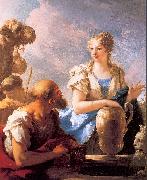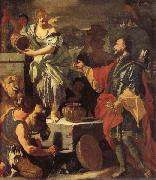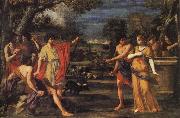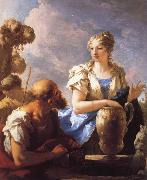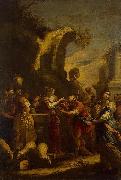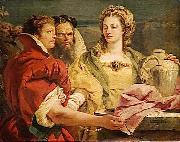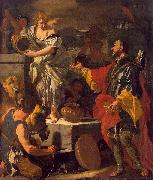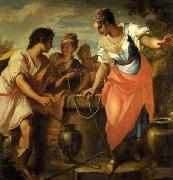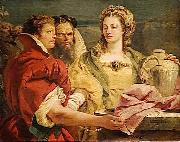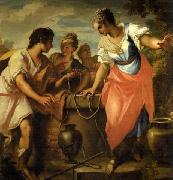Wholesale Oil Painting No Minimum |
|||||||||||
|
|
|||||||||||

|
|||||||||||
|
|
|
||||||||
PELLEGRINI, Giovanni AntonioItalian Rococo Era Painter, 1675-1741 Italian painter. With Sebastiano Ricci and Jacopo Amigoni he was the most important Venetian history painter of the early 18th century. By uniting the High Renaissance style of Paolo Veronese with the Baroque of Pietro da Cortona and Luca Giordano, he created graceful decorations that were particularly successful with the aristocracy of central and northern Europe. He travelled widely, working in Austria, England, the Netherlands, Germany and France. |
||||||||
|
|
||||||||
Rebecca at the Well
Rebecca at the Well Painting ID:: 19822 |
1708-13
Oil on canvas
National Gallery, London 1708-13 Oil on canvas National Gallery, London |
|||||||
|
|
||||||||
Francesco Solimena1657-1747 Italian Francesco Solimena Gallery Francesco Solimena was born in Canale di Serino, near Avellino. He received early training from his father, Angelo Solimena, with whom he executed a Paradise for the cathedral of Nocera (place where he spend a big part of his life) and a Vision of St. Cyril of Alexandria for the church of San Domenico at Solofra. He settled in Naples in 1674, there he worked in the studio of Francesco di Maria and later Giacomo del Po[1]. He apparently had taken the clerical orders, but was patronized early on, and encouraged to become an artist by Cardinal Vincenzo Orsini (later Pope Benedict XIII)[2]. By the 1680s, he had independent fresco commissions, and his active studio came to dominate Neapolitan painting from the 1690s through the first four decades of the 18th century. He modeled his art??for he was a highly conventional painter??after the Roman Baroque masters, Luca Giordano and Giovanni Lanfranco, and Mattia Preti, whose technique of warm brownish shadowing Solimena emulated. Solimena painted many frescoes in Naples, altarpieces, celebrations of weddings and courtly occasions, mythological subjects, characteristically chosen for their theatrical drama, and portraits. His settings are suggested with a few details??steps, archways, balustrades, columns??concentrating attention on figures and their draperies, caught in pools and shafts of light. Art historians take pleasure in identifying the models he imitated or adapted in his compositions. His numerous preparatory drawings often mix media, combining pen-and-ink, chalk and watercolor washes. Francesco Solimena 'A study for the fresco cycle in the Sacristy of San Paolo Maggiore in Naples', Whitfield Fine Art.A typical example of the elaborately constructed allegorical "machines" of his early mature style, fully employing his mastery of chiaroscuro, is the Allegory of Rule (1690) from the Stroganoff collection, which has come to the State Hermitage Museum, St Petersburg. He apparently hoped to see his son Orazio follow a career in the law, for which he received a doctorate (de Domenici), but also became a painter. His large, efficiently structured atelier became a virtual academy, at the heart of cultural life in Naples. Among his many pupils were Francesco de Mura (1696-1784) , Giuseppe Bonito (1707-89), Pietro Capelli, Gaspare Traversi, and most notably Corrado Giaquinto and Sebastiano Conca. The Scottish portraitist Allan Ramsay spent three years in Solimena's studio. Solimena amassed a fortune, was made a baron and lived in sumptuous style founded on his success. Francesco Solimena died at Barra, near Naples, in 1747. |
||||||||
|
|
||||||||
|
|
Rebecca at the Well
Rebecca at the Well Painting ID:: 29103 |
mk65
Oil on canvas
28x25"
mk65 Oil on canvas 28x25" |
||||||
|
|
||||||||
Giacinto GimignaniItalian Painter , Pistoia, 1611 - Roma, 1681 |
||||||||
|
|
||||||||
|
|
Rebecca at the Well
Rebecca at the Well Painting ID:: 29965 |
mk67
Oil on canvas
37x56 11/16in
Pitti,Palatine Gallery
mk67 Oil on canvas 37x56 11/16in Pitti,Palatine Gallery |
||||||
|
|
||||||||
PELLEGRINI, Giovanni AntonioItalian Rococo Era Painter, 1675-1741 Italian painter. With Sebastiano Ricci and Jacopo Amigoni he was the most important Venetian history painter of the early 18th century. By uniting the High Renaissance style of Paolo Veronese with the Baroque of Pietro da Cortona and Luca Giordano, he created graceful decorations that were particularly successful with the aristocracy of central and northern Europe. He travelled widely, working in Austria, England, the Netherlands, Germany and France. |
||||||||
|
|
||||||||
|
|
Rebecca at the Well
Rebecca at the Well Painting ID:: 43269 |
mk170
1708-1713
Oil on canvas
127.3x104.5cm
mk170 1708-1713 Oil on canvas 127.3x104.5cm |
||||||
|
|
||||||||
CASTELLO, ValerioItalian painter, Genoese school (b. 1624, Genova, d. 1659, Genova) Painter and draughtsman, son of Bernardo Castello. He was one of the leading Ligurian painters of the 17th century, whose art developed from a continuous and passionate study of a wide range of sources. His paintings of mythological and religious subjects unite an elegant figure style with an interest in dramatic and violent compositions; his touch is spontaneous and his palette vibrant with reds and pinks, blues and yellows. His brilliant decorative frescoes introduced the splendour of the High Baroque to Genoese painters. He was well known for his rapid oil sketches, with light and lively brushwork, which anticipate aspects of the Rococo. |
||||||||
|
|
||||||||
|
|
Rebecca at the Well
Rebecca at the Well Painting ID:: 67678 |
Technique Oil on canvas
Dimensions X cm
Technique Oil on canvas Dimensions X cm |
||||||
|
|
||||||||
Paolo VeroneseItalian Mannerist Painter, ca.1528-1588 Italian painter and draughtsman. With Titian and Tintoretto he makes up the triumvirate of great painters of the late Renaissance in Venice. He is known as a supreme colourist and for his illusionistic decorations in both fresco and oil. His large paintings of biblical feasts executed for the refectories of monasteries in Venice and Verona are especially celebrated. He also produced many altarpieces, history and mythological paintings and portraits. His compositional sketches in pen, ink and wash, figure studies in chalk, and chiaroscuro modelli and ricordi form a significant body of drawings. |
||||||||
|
|
||||||||
|
|
Rebecca at the Well
Rebecca at the Well Painting ID:: 70746 |
Date 1580-1585
Medium Oil on canvas
Dimensions 145.5 x 282.7 cm
Date 1580-1585 Medium Oil on canvas Dimensions 145.5 x 282.7 cm |
||||||
|
|
||||||||
Giovanni Domenico Tiepolo(August 30, 1727 - March 3, 1804) was a Venetian painter and printmaker in etching. He was the son of artist Giovanni Battista Tiepolo and elder brother of Lorenzo Baldissera Tiepolo.. Domenico was born in Venice, studied under his father, and by the age of 13 was the chief assistant to him. He was one of the many assistants, including Lorenzo, that transferred the designs of his father (executed in the 'oil sketch' invented by the same). By the age of 20, he was producing his own work for commissioners. He assisted his father in Werzburg 1751-3, decorating the famous stairwell fresco, in Vicenza at the Villa Valmarana in 1757, and in Madrid at the palace of Charles III from 1762-70. |
||||||||
|
|
||||||||
|
|
Rebecca at the Well
Rebecca at the Well Painting ID:: 71071 |
late 18th century
Oil on canvas
late 18th century Oil on canvas |
||||||
|
|
||||||||
Francesco Solimena1657-1747 Italian Francesco Solimena Gallery Francesco Solimena was born in Canale di Serino, near Avellino. He received early training from his father, Angelo Solimena, with whom he executed a Paradise for the cathedral of Nocera (place where he spend a big part of his life) and a Vision of St. Cyril of Alexandria for the church of San Domenico at Solofra. He settled in Naples in 1674, there he worked in the studio of Francesco di Maria and later Giacomo del Po[1]. He apparently had taken the clerical orders, but was patronized early on, and encouraged to become an artist by Cardinal Vincenzo Orsini (later Pope Benedict XIII)[2]. By the 1680s, he had independent fresco commissions, and his active studio came to dominate Neapolitan painting from the 1690s through the first four decades of the 18th century. He modeled his art??for he was a highly conventional painter??after the Roman Baroque masters, Luca Giordano and Giovanni Lanfranco, and Mattia Preti, whose technique of warm brownish shadowing Solimena emulated. Solimena painted many frescoes in Naples, altarpieces, celebrations of weddings and courtly occasions, mythological subjects, characteristically chosen for their theatrical drama, and portraits. His settings are suggested with a few details??steps, archways, balustrades, columns??concentrating attention on figures and their draperies, caught in pools and shafts of light. Art historians take pleasure in identifying the models he imitated or adapted in his compositions. His numerous preparatory drawings often mix media, combining pen-and-ink, chalk and watercolor washes. Francesco Solimena 'A study for the fresco cycle in the Sacristy of San Paolo Maggiore in Naples', Whitfield Fine Art.A typical example of the elaborately constructed allegorical "machines" of his early mature style, fully employing his mastery of chiaroscuro, is the Allegory of Rule (1690) from the Stroganoff collection, which has come to the State Hermitage Museum, St Petersburg. He apparently hoped to see his son Orazio follow a career in the law, for which he received a doctorate (de Domenici), but also became a painter. His large, efficiently structured atelier became a virtual academy, at the heart of cultural life in Naples. Among his many pupils were Francesco de Mura (1696-1784) , Giuseppe Bonito (1707-89), Pietro Capelli, Gaspare Traversi, and most notably Corrado Giaquinto and Sebastiano Conca. The Scottish portraitist Allan Ramsay spent three years in Solimena's studio. Solimena amassed a fortune, was made a baron and lived in sumptuous style founded on his success. Francesco Solimena died at Barra, near Naples, in 1747. |
||||||||
|
|
||||||||
|
|
Rebecca at the Well
Rebecca at the Well Painting ID:: 71553 |
Date c. 1700
Medium Oil on canvas
Dimensions 72 x 63 cm (28.35 x 24.8 in)
Date c. 1700 Medium Oil on canvas Dimensions 72 x 63 cm (28.35 x 24.8 in) |
||||||
|
|
||||||||
Niccolo Bambini(1651-1736) was an Italian painter of the late-Renaissance and early-Baroque periods. He was born in Venice, and first studied under Giulio Mazzoni at Venice; but afterwards went to Rome, where he became a pupil of Carlo Maratti. He painted for the church of San Stefano soon after his return from Rome. He died in Venice. He had two sons who were painters, Giovanni and Stefano. |
||||||||
|
|
||||||||
|
|
Rebecca at the well
Rebecca at the well Painting ID:: 72186 |
Oil on canvas
215 x 203 cm
Oil on canvas 215 x 203 cm |
||||||
|
|
||||||||
Giovanni Domenico Tiepolo(August 30, 1727 - March 3, 1804) was a Venetian painter and printmaker in etching. He was the son of artist Giovanni Battista Tiepolo and elder brother of Lorenzo Baldissera Tiepolo.. Domenico was born in Venice, studied under his father, and by the age of 13 was the chief assistant to him. He was one of the many assistants, including Lorenzo, that transferred the designs of his father (executed in the 'oil sketch' invented by the same). By the age of 20, he was producing his own work for commissioners. He assisted his father in Werzburg 1751-3, decorating the famous stairwell fresco, in Vicenza at the Villa Valmarana in 1757, and in Madrid at the palace of Charles III from 1762-70. |
||||||||
|
|
||||||||
|
|
Rebecca at the Well
Rebecca at the Well Painting ID:: 72225 |
Date late 18th century
Medium Oil on canvas
Dimensions ? cm
cyf Date late 18th century Medium Oil on canvas Dimensions ? cm cyf |
||||||
|
|
||||||||
Niccolo Bambini(1651-1736) was an Italian painter of the late-Renaissance and early-Baroque periods. He was born in Venice, and first studied under Giulio Mazzoni at Venice; but afterwards went to Rome, where he became a pupil of Carlo Maratti. He painted for the church of San Stefano soon after his return from Rome. He died in Venice. He had two sons who were painters, Giovanni and Stefano. |
||||||||
|
|
||||||||
|
|
Rebecca at the well
Rebecca at the well Painting ID:: 73810 |
Date Unknown date
Medium Oil on canvas
Dimensions 215 x 203 cm
cyf Date Unknown date Medium Oil on canvas Dimensions 215 x 203 cm cyf |
||||||
|
|
||||||||
|
Niccolo Bambini (1651-1736) was an Italian painter of the late-Renaissance and early-Baroque periods. He was born in Venice, and first studied under Giulio Mazzoni at Venice; but afterwards went to Rome, where he became a pupil of Carlo Maratti. He painted for the church of San Stefano soon after his return from Rome. He died in Venice. He had two sons who were painters, Giovanni and Stefano. Rebecca at the well Date Unknown date Medium Oil on canvas Dimensions 215 x 203 cm cyf |
||||||||
|
|
||||||||
|
Prev Next
|
||||||||
|
|
||||||||
|
Related Paintings to Niccolo Bambini :. |
||||||||
|
|
||||||||
|
CONTACT US |
